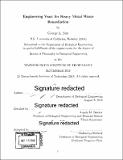Engineering yeast for heavy metal waste remediation
Author(s)
Sun, George L.(George Le-Le)
Download1144859713-MIT.pdf (33.46Mb)
Other Contributors
Massachusetts Institute of Technology. Department of Biological Engineering.
Advisor
Angela M. Belcher.
Terms of use
Metadata
Show full item recordAbstract
The global rate of waste production has consistently outpaced the world's ability to manage and remediate it. Specifically, global consumption of raw materials, unrenewable energy sources, and disposal of electronic goods have contaminated water sources with heavy metals causing enviornmental damage and public health concerns. Despite the urgent need to contain and remove metals from the environment, there still does not exist robust and complete remediation technologies. Physicochemical technologies like chemical precipitation, absorption, and ion-exchange lack the specificity for metal capture, produce their own secondary-waste in the form of chemical byproducts or sludge, and have a high cost barrier requiring development of dedicated infrastructure and technical expertise. Instead, this work investigates biologically-derived strategies for managing waste, technologies also known as bioremediation. Principles from chemical precipitation, absorption, and ion-exchange were analogously designed in S. cerevisae-the common baker's yeast. The three analogies were: engineering yeast sulfur metabolic pathways for controlled metal sulfide precipitation; designing new metal trafficking schemes using membrane metal transporters; and engineering supramolecular forming proteins for yeast-protein metal chelation and sequestration. For all methods, metal removal were between 50-90% efficiency for heavy metals such as Cu, Cd, Hg, and Pb. Furthermore, 2-4 rounds of processing eliminated almost 100 [mu]M of metal, 100-1000 fold greater than EPA toxicity thresholds. Strategies to retrieve and recycle captured metals were also investigated, such as precipitating metal sulfide crystals onto the yeast surface, compartmentalizing metals into the yeast vacuole, or sedimenting bound metals into cell-protein complexes. Relying on yeast takes advantage of their autonomous growth, ease of engineering, and its ubiquitous presence in the household and consumer market. The purpose of this work was to show that the same yeast used for brewing and baking can be harnessed for clean water applications.
Description
Thesis: Ph. D., Massachusetts Institute of Technology, Department of Biological Engineering, 2019 Cataloged from PDF version of thesis. Includes bibliographical references.
Date issued
2019Department
Massachusetts Institute of Technology. Department of Biological EngineeringPublisher
Massachusetts Institute of Technology
Keywords
Biological Engineering.